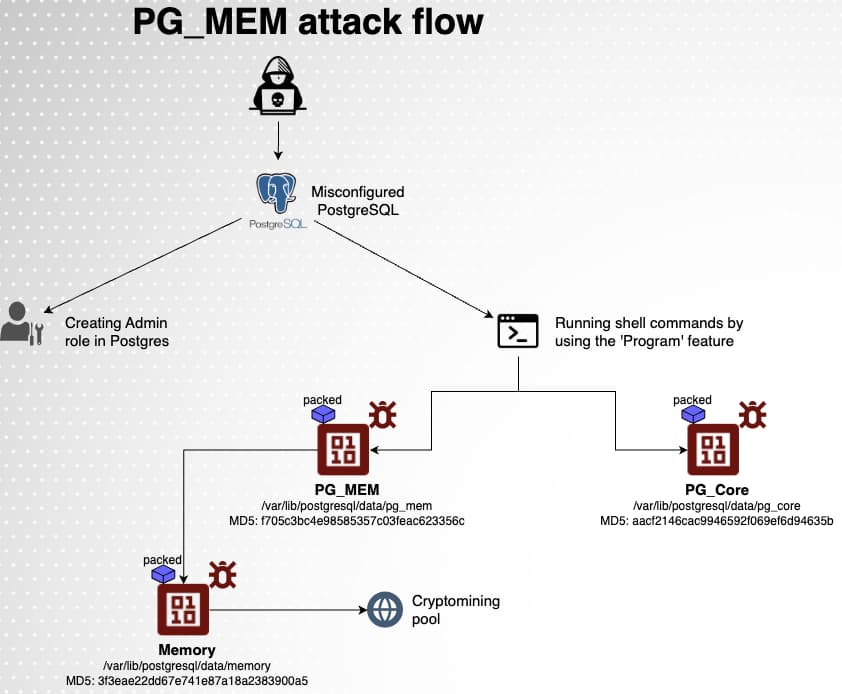Deeba Ahmed
2024-08-21 14:32:22
hackread.com
The new PG_MEM malware targets PostgreSQL databases, exploiting weak passwords to deliver payloads and mine cryptocurrency. Researchers warn that 800,000 publicly accessible instances are vulnerable. Learn how this multi-stage attack works and how to protect your PostgreSQL environment.
Aqua Security’s threat research team, Nautilus, has discovered PG_MEM, a new malware that can infiltrate PostgreSQL databases, deliver payloads, and mine cryptocurrency.
PostgreSQL, also known as Postgres, is an open-source relational database management system researchers observed as susceptible to brute force attacks. These attacks exploit weak passwords resulting from misconfiguration or insufficient identity controls, a common issue in large organizations.
This, according to the company’s blog post, allows them to gain access to the database and execute arbitrary shell commands by leveraging the COPY … FROM PROGRAM command, leading to malicious activities like data theft or malware deployment.
Nautilus researchers identified 800,000 publicly accessible instances of PostgreSQL databases as vulnerable to this malware. The ultimate goal of the attack is to deploy cryptocurrency miners to exploit system resources.
The PG_MEM malware employs a multi-stage attack flow to compromise PostgreSQL databases and deploy cryptocurrency miners. It starts with the attacker initiating a brute force attack on the PostgreSQL database, repeatedly attempting to guess the database credentials. Once this gets done, attackers create a new superuser role with high privileges. This allows them to maintain access to the database even if the original credentials are changed.
Now, the attacker gathers information about the system, such as the PostgreSQL server version and configuration to identify potential vulnerabilities and tailor the attack accordingly. The attacker downloads malicious payloads from a remote server, which typically includes cryptocurrency mining software and tools for persistence and evasion.
Researchers noted that two files are downloaded from the attacker’s remote server, with the first block of commands aimed at delivering the first payload. They used a temporary table to store code and data, clearing it before and after each command. As soon as the payloads are downloaded on the compromised system, the cryptocurrency mining software begins to consume system resources to mine cryptocurrency.
The attacker takes steps to ensure persistence, such as creating cron jobs or modifying system configuration files, which helps the malware to continue operating even after the system is restarted. Moreover, they evade detection by deleting files and logs related to their malicious activity.
This is concerning as PostgreSQL databases are commonly used for web, mobile, geospatial, and analytics applications. To protect PostgreSQL environments, organizations should monitor for suspicious activity, implement strong authentication using robust passwords and multi-factor authentication, isolate databases from the network, and use security tools to promptly detect and prevent malicious activity.
RELATED TOPICS
Support Techcratic
If you find value in our blend of original insights (Techcratic articles and Techs Got To Eat), up-to-date daily curated articles, and the extensive technical work required to keep everything running smoothly, consider supporting Techcratic with Bitcoin. Your support helps me, as a solo operator, continue delivering high-quality content while managing all the technical aspects, from server maintenance to future updates and improvements. I am committed to continually enhancing the site and staying at the forefront of trends to provide the best possible experience. Your generosity and commitment are deeply appreciated. Thank you!
Bitcoin Address:
bc1qlszw7elx2qahjwvaryh0tkgg8y68enw30gpvge
Please verify this address before sending any funds to ensure your donation is directed correctly.
Bitcoin QR Code
Your contribution is vital in supporting my efforts to deliver valuable content and manage the technical aspects of the site. To donate, simply scan the QR code below. Your generosity allows me to keep providing insightful articles and maintaining the server infrastructure that supports them.

Privacy and Security Disclaimer
- No Personal Information Collected: We do not collect any personal information or transaction details when you make a donation via Bitcoin. The Bitcoin address provided is used solely for receiving donations.
- Data Privacy: We do not store or process any personal data related to your Bitcoin transactions. All transactions are processed directly through the Bitcoin network, ensuring your privacy.
- Security Measures: We utilize industry-standard security practices to protect our Bitcoin address and ensure that your donations are received securely. However, we encourage you to exercise caution and verify the address before sending funds.
- Contact Us: If you have any concerns or questions about our donation process, please contact us via the Techcratic Contact form. We are here to assist you.
Disclaimer: As an Amazon Associate, Techcratic may earn from qualifying purchases.













































![J1772 Charging Adapter for Tesla Model 3 Y S X [Safety Certified] 80 Amp 240V AC Fast…](https://techcratic.com/wp-content/uploads/2024/11/71Mii9k40bL._AC_SL1500_-360x180.jpg)














![Japanese Movie – The X From Outer Space (Uchu Dai Kaijyu Girara) [Japan BD] SHBR-263](https://techcratic.com/wp-content/uploads/2024/11/81rV3BDVGJL._SL1024_-360x180.jpg)








